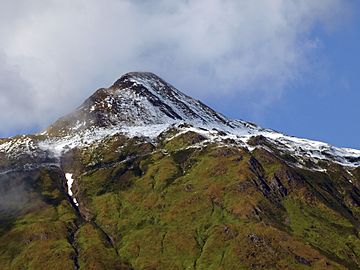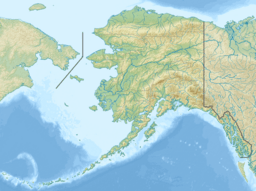McGinnis Mountain facts for kids
Quick facts for kids McGinnis Mountain |
|
|---|---|

McGinnis Mountain summit
|
|
| Highest point | |
| Elevation | 4,232 ft (1,290 m) |
| Prominence | 656 ft (200 m) |
| Parent peak | Stroller White Mountain |
| Geography | |
| Location | Tongass National Forest Juneau Borough Alaska, United States |
| Parent range | Coast Mountains Boundary Ranges Juneau Icefield |
| Topo map | USGS Juneau B-2 |
McGinnis Mountain, also known as Mount McGinnis, is a mountain in the U.S. state of Alaska. It stands about 4,232 feet (1,290 meters) tall. This peak is part of the Boundary Ranges and is located near the bottom of the famous Mendenhall Glacier.
You can find McGinnis Mountain inside the huge Tongass National Forest. It's about 11 miles (18 km) northwest of Juneau, Alaska, and 6 miles (10 km) north of the Juneau International Airport. Even though it's not one of the tallest mountains, it looks very impressive. This is because it rises sharply from sea level at Auke Bay in just a few miles. This steep rise from low ground is called "relief."
Many people take pictures of McGinnis Mountain along with Stroller White Mountain. Stroller White is a taller peak, about 5,118 feet (1,560 meters) high, and is located about 1.6 miles (2.6 km) north. These two mountains often appear together in photos because they form a beautiful background behind Mendenhall Lake, which is a popular spot for tourists and outdoor fun.
Mountain History
The name "McGinnis Mountain" was officially recognized in 1930 by the United States Geological Survey (USGS). The mountain got its name from McGinnis Creek, a stream that flows down its northern side.
McGinnis Creek was first called "McInnis River" in 1891. This name was given by John McInnis and Edward Brennan, who had claimed land in the area. Later, in 1903, the USGS reported the name as McGinnis Creek, and it has been known by that name ever since.
Weather and Climate
McGinnis Mountain is in a subarctic climate zone. This means it has cold, snowy winters and mild summers. Temperatures can drop below −4 °F (−20 °C), and with the wind, it can feel even colder, sometimes below −22 °F (−30 °C).
This type of climate helps support the nearby Mendenhall Glacier and the large Juneau Icefield to the east of the mountain. If you're thinking about climbing, May and June are usually the best months. The weather during these months is often more favorable for outdoor activities.
Images for kids
-
McGinnis Mountain (left), Mendenhall Towers, and Mount Wrather reflected in Auke Lake




